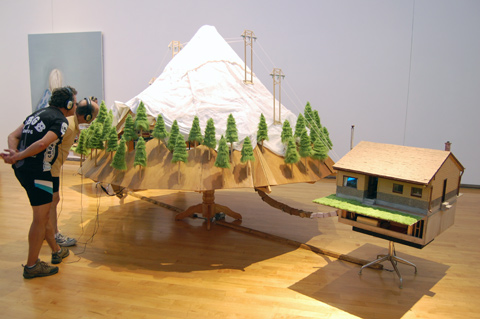
THE MOUNTAIN Graeme Patterson's installation goes for surreal spectacle. |
These days you often hear how the Web has made everything more accessible, how the art world is flat, how the art capitals no longer have a monopoly on ideas and whatnot. But then you notice that half of the artists in the 2012 Whitney Biennial, a survey of "contemporary art in America," reside in New York. And nearly all the rest hail from LA or San Francisco. Or a third of all the artists in Phaidon's 2009 book surveying Painting Today across the globe are also in New York. Do all great artists in fact live in New York or LA or a handful of other art capitals? Do artists elsewhere just need better advertising? Or could it be that the art world still has a major geographic bias?
For the record, let's note a significant structural problem: American contemporary art curators, with limited time and money, do much of their scouting via a handful of biennials, art fairs (Miami!), magazines (mainly published in New York), and New York and LA neighborhoods. Which offer the benefits of one-stop shopping, but result in most everybody curating from the same pre-approved pool. It's much more time-consuming and professionally risky to try to identify talent outside these usual suspects.
So one of the extraordinary things about "Oh, Canada" at Mass MoCA (1040 Mass MoCA Way, North Adams, through April 1) — which features 62 living Canadian artists and collectives and is billed as "the largest survey of contemporary Canadian art ever produced outside Canada" — is that curator Denise Markonish spent three years crisscrossing Canada and visiting more than 400 artists.
The show is part of the "New Regionalism" that's evidenced in recent exhibits like the Getty's "Pacific Standard Time," which featured 60-plus California venues digging into post-War LA art, and the Pennsylvania Academy of Fine Arts Museum's "here." — a sort of fly-over-country biennial. This October, the Southeastern College Art Conference will offer a session on "Regionalism in Art: New Perceptions of Here (vs There)." This art-world locavore movement seems driven by fatigue with glitzy biennials and art fairs, prompting a search for (perhaps) more soulful works off the beaten path.
"Oh, Canada" feels like a revelation because Canada is part of the geography the US art world typically ignores. That it's showcased outside Canada is vital. A limitation of many regional biennials — like the ICA Foster Prize or DeCordova Biennial here — is that they rarely travel outside their homelands, and so do little to spread the word out of town.
What does Markonish say we're missing? She purposely (mostly) excluded stars — like Vancouver photographer Jeff Wall, the subject of a major 2007 New York MoMA retrospective — to focus on fresh faces. Which can give a misleading impression that all Canadian artists are nobodies, but also generates a sense of discovery. There are examples of familiar styles: deadpan architectural photos; a meditative/poetic/boring hour-long video of flapping window curtains; and Garry Neill Kennedy's conceptual-art archive of found photos documenting planes used by the CIA for the "extraordinary rendition" of suspected terrorists to secret foreign locations allegedly more amenable to torture.